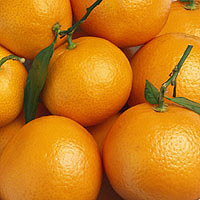Penn Herb Wellness Guide
Oranges

Varieties
Oranges fall into three categories: bitter, loose-skinned (like mandarin oranges), and sweet; each type has many individual varieties.
Sweet oranges are used chiefly for juicing or eating. They include the Valencia, Navel, and Temple oranges.
The Navel orange, which is grown in California, is considered an eating orange, since its sweet pulp tends to turn a little bitter when the juice is exposed to air.
Valencia oranges are enjoyed for both eating and juicing, although commercially the Valencia is considered the best juicing orange.
An orange hybrid bearing an orange and red rind with red flesh is called blood orange and is frequently available.
The Temple orange, named after the man who created it, is a flavorful orange-tangerine hybrid. Bitter oranges, also known as Seville oranges, are named after the Spanish city of the same name. They are seldom seen in markets and are used chiefly for marmalade or for their peel (in liqueurs).
Copyright 2025 TraceGains, Inc. All rights reserved.
Learn more about TraceGains, the company.
The information presented in the Food Guide is for informational purposes only and was created by a team of USregistered dietitians and food experts. Consult your doctor, practitioner, and/or pharmacist for any health problem and before using any supplements, making dietary changes, or before making any changes in prescribed medications. Information expires December 2025.


